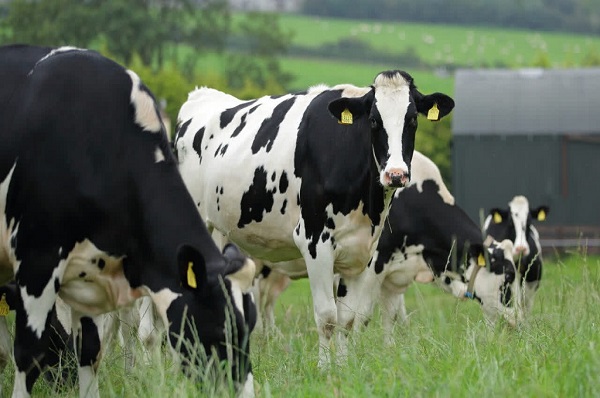
Enhancing Fiber Digestion Efficiency in Ruminants: Technologies and Strategies
Fiber constitutes a crucial nutrient in the diet of ruminants, primarily sourced from forages such as pasture, silage, hay, or agricultural by-products.Fiber serves two essential roles in nutrition. Firstly, it provides physical capacity, promoting animal salivation, which is vital for proper rumen function and overall animal health.The second, and highly significant role, is its ability to be degraded in the rumen by microorganisms, producing volatile fatty acids, the primary energy source for ruminants.However, the capacity for fiber degradation varies significantly among different nutrients in the diet, with one of the main influencing factors being the organization and composition of this fiber fraction. To gain a better understanding of fiber degradation capacity, it is essential to comprehend the structure and role of fiber in plants.
Fiber, also known as the cell wall, is a complex and indispensable structure for plants. It is responsible for providing structural support, integrity, flexibility, and protection against pathogens and stress, acting as a physical barrier. Fiber mainly comprises three compounds: cellulose, hemicellulose, and lignin.
While cellulose and hemicellulose can be degraded in the rumen, producing volatile fatty acids as mentioned earlier, lignin acts as a barrier, hindering the degradation of other compounds.
This happens because for a nutrient to undergo degradation in the rumen, it requires the synthesis of particular enzymes. However, the synthesis of enzymes that break down lignin in the rumen is relatively insignificant.
Decades of research have demonstrated that increasing fiber degradation is related to:
1- Increased productivity
2- Better profits
3- Reduced invironmental impact, both in daqiryv and beef supply chains.
As a result, various technologies and strategies have been extensively studied and developed to enhance fiber degradation.
These technologies and strategies encompass mechanical processing, genetic improvement, chemical treatment, and enzymatic treatment. |
Mechanical Processing
Mechanical processing positively impacts fiber degradation, making it more efficient.
Particle size plays a critical role in stimulating chewing and salivation. Therefore, particle size reduction should be moderate. Conversely, longer particles can reduce consumption due to slower passage rate and increased sensation of satiety attributed to fullness.The increased digestion resulting from particle size reduction is associated with an augmented contact surface, leading to a higher rumen degradation rate and, consequently, intensified animal intake. Among the various processing methods, chopping, grinding, and pelleting are the most popular.
Hybrid Utilization
The second strategy to increase fiber digestion comes from the use of hybrids with reduced lignin concentration compared to conventional plants. A well-known example of this technology is BMR hybrids. BMR stands for Brown-Midrib, referring to the brown midrib characteristic of the hybrid.This name comes from the hybrid’s feature, as the gene confers the presence of brown coloration in the central veins of the leaves. Ferraretto and Shaver reported in a meta-analysis study the increased fiber digestibility, dry matter intake, and milk production in cows fed BMR corn silage compared to traditional corn silage.
Similar to corn, research has also shown that BMR sorghum presents increased fiber digestion, intake, and milk production compared to traditional sorghum. Besides corn and sorghum, improvement technologies are also being applied to increase alfalfa digestion.
Chemical Treatments
Chemical treatments represent another strategy employed to increase fiber digestion. These treatments involve using substances such as ammonia, sodium hydroxide, and calcium hydroxide.The aim of these treatments is to break the bond between hemicellulose and lignin and disrupt the crystallization of cellulose, thereby increasing the availability of both fibrous carbohydrates: hemicellulose and cellulose.
The increased availability of these carbohydrates enables bacteria in the rumen to have greater access to these fractions, consequently enhancing their degradations.
However, it is essential to exercise caution when using chemical treatments as they can cause intoxication and corrode agricultural machinery.
Despite the potential risks, chemical treatments are highly efficient in improving fiber digestion, especially for ingredients with low digestibility, such as agro-industrial residues. This favors the use of these residues to replace traditional ingredients and reduce production costs.
Enzimatic Treatment
Similarly, fibrolytic enzymes have shown promising results in enhancing fiber digestion, increasing intake, and improving animal production when used to treat ingredients in ruminant nutrition. The effects of fibrolytic enzymes can be divided into three parts: pre-ingestive, ruminal, and post-ruminal.
1-The pre-ingestion effect involves improving the composition of the ingredient before offering it to the animal. This includes reducing cellulose and hemicellulose, which are hydrolyzed into more accessible carbohydrates for microorganisms.
2-Regarding the ruminal effect, carbohydrates derived from the hydrolysis of cellulose and hemicellulose are fermented more rapidly and efficiently by ruminal bacteria, resulting in greater ruminal degradation and increased animal intake due to an accelerated passage rate.
3-The post-ruminal effect is related to reducing viscosity in the intestine, which can negatively affect the absorption of other nutrients. For instance, certain types of hemicellulose have a viscous aspect. If intact hemicellulose reaches the small intestine, it may hinder diet utilization by forming a barrier.
Research continues to develop new technologies and strategies associated with enzymes. One promising area involves enzymes capable of hydrolyzing lignin. Certain types of fungi, like white rot fungus, synthesize numerous enzymes that hydrolyze lignin
Recent studies conducted at the State University of Maringá, under the guidance of Professor Dr. Lucia Zeoula, in collaboration with Professor Dr. Paula Pintro, demonstrated that enzymes synthesized by white rot fungus reduced the concentration of lignin, cellulose, and hemicellulose in corn silage while increasing in vitro fiber digestion of the treated material.
Similar results were observed in lactating goats when mushroom cultivation residue was used as an enzymatic source to treat corn silage during ensiling (Agustinho et al. ,2021).
In conclusion, there are numerous technologies available to enhance fiber digestibility in ruminants, and new innovations are continually being tested and introduced to the market. The choice of which technology best suits specific conditions and the evaluation of its cost-benefit should be made by professionals involved in the field.
